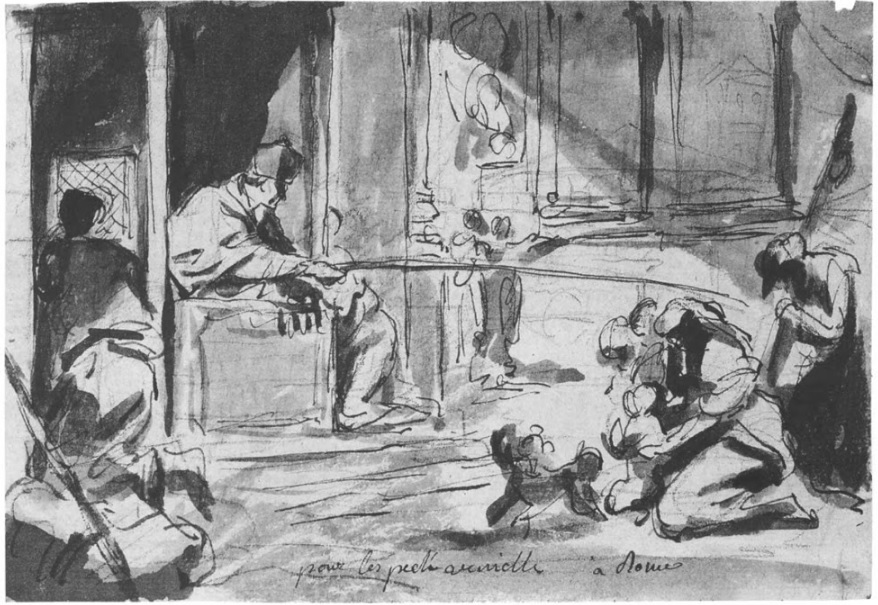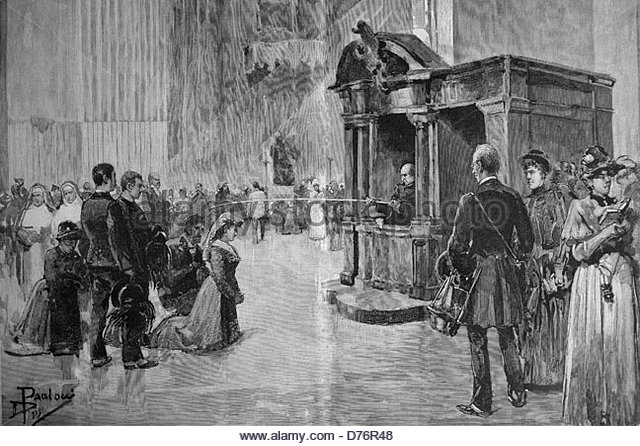 From a reader…
From a reader…
QUAERITUR:
I recently read about the indulgences formerly attached to being touched by the ‘penitential wand’ in Rome in the Raccolta. I’ve been trying to find more information about this practice online, all to no avail. I wonder if you could write about it? Seems like something as ‘rigid’ as this could do us well these days!
Right. We are now into serious Catholic cool arcana.
The penitential virga or ferula, bachetto penitenziario, wand, or rod, is sadly out of use … for now.
These were instruments – longish rods – used by special confessors with wider jurisdiction and my major and minor penitentiaries, especially the Major Penitentiary of the Church, whose jurisdiction when it comes to matter of confession or indulgences is second only to the Pope’s.
 I suspect it’s use stemmed from Ps 23: “Virga tua et baculus tuus consolata sunt… Thy rod and thy staff they have comforted me.” The sight of these churchy gizmos would have given great confidence and consolation to the penitent or one seeking an indulgence; he would know that this confessor had greater jurisdiction.
I suspect it’s use stemmed from Ps 23: “Virga tua et baculus tuus consolata sunt… Thy rod and thy staff they have comforted me.” The sight of these churchy gizmos would have given great confidence and consolation to the penitent or one seeking an indulgence; he would know that this confessor had greater jurisdiction.
In the great Roman Major Basilicas there were special indulgences granted to pilgrims on certain days of the year and special occasions. You would approach the Major (or Minor) Penitentiary, seated on his great throne-like chair (for he was like a tribune or judge), kneel before him and – if you had a document saying that you had fulfilled your pilgrimage, etc., it would be brought to him – he would then bop you on your penitential head with the penitential wand in his benignity, thus granting you the indulgence. There is still one of these chairs in St. John Lateran.
At first, I think there were only 10 days indulgence granted by Benedict XIII, of happy recollection, and Benedict XIV of even happier memory increased that to 40. on certain days it was of 100 days. In 1917 it was increased to 300 days… inflation?
When we are elected Pope, this practice will return.
Their use extended even into the time of Our predecessor Paul VI. There were attached to the doors of the confessionals in St. Peter’s a rod rather like a standard fishing in dimensions which the penitentiaries, confessors, would use to grant indulgences with a tap on the head to those who passed by and requested one.
It is to be suspected that sometimes their use might possibly have been – in the right hands – wrong hands? – a source of general amusement. This may be why Paul VI made the mistake of getting rid of them.


































Was the penitential wand only used for that, or was it the same stick used in the formal rite of lifting an excommunication?
I found this is the Roman Ritual and often wondered about it:
The penitent kneels before the priest, and, if a male, his shoulders are uncovered down to his shirt. The priest, who is seated, lightly strikes the penitent with a rod or cord, reciting the following psalm:
Psalm 50: “Have mercy on me, O God,” etc. (see Psalm 50)
EWTN has this useful explanation of what those old grants of “so many days” indulgences actualy meant – and the fact that they have been abolished.
When you are Pope, Father, please also institute an “unpenitential wand” for use in whipping unrepentant promoters of heresy (and maybe the odd infidel tourist misbehaving in an Archbasilica).
[No no. They will be turned over to the reinstated Noble Guard, which will be a less than agreeable experience.]
Hmmm…I’m thinking it adds a new dimension to “I will make you fishers of men”(ooops, persons, mustn’t be rigid). But, this is so cool! A cool tool, a baculum frigidum, even. Sed non rigidum. Numquam rigidi estote.
Wait, all of those ruler-toting nuns (I’ve heard tales, but never met one!) weren’t carrying penitential wands?
As a parent, a penitential wand sounds like it might be a useful implement, more to inflict penance than to absolve of it ;) Perhaps I will rename my spatula the “penitential wand”.
Nearly the opposite of Aubrey’s day when the bailiff with a touch of his “tipstaff” would arrest you for debt!
[Nice O’Brian reference! But the idea is the same: the staff is a symbol of jurisdiction.]
Their use could arguably still be VALID, simply as an accoutrement, to the First and Third General Grants of Indulgence
Chantgirl, when I attended Catholic School in England in the 1950’s the nuns had recourse to a cane about 2-3 feet long, about the diameter of a fishing rod, which was used to deal with various kinds of misbehavior, usually a couple of wacks around the ankles (we boys all wore short pants in those days so we were somewhat vulnerable in that area).
all of those ruler-toting nuns (I’ve heard tales, but never met one!)
I’ve never met one either, but my mom took piano lessons from the Ursaline sisters and apparently they used to smack students’ fingers if they used the wrong fingers while playing. My mom gave my piano teacher permission to do the same…
So now we know where Harry Potter got his idea for a wand. Always copying Mother Church.
I’ve read all the scripture there is on your Eucharist. 12 men reclining at table; cup of wine; plate of flat bread; simple instructions to be followed. Later, the Grand Commission; ‘Go, teach.’ Now I see here [electronic] pages of notes and comments on this obscure corner of [non-Biblical] history, to be cherished by its In Crowd.
It’s no wonder that many commentators, including one of your fellows regularly on new.advent.com, notice that young people are avoiding your “catholic” religion in droves. Connection?
Doug young people are leaving religion period. Most of my age group (20somethings) isn’t to be found in religious houses of any denomination. But the ones who stay or converted are often very interested in history and cool catholic trivia:)
Now I have a better interpretation of when Fr. Florio always used to ask me in the morning, Sei abbacchiato?
[Well… that’s like asking if you are down or tired… “beat” in the sense of being depressed or weary. It does come etymologically from Latin baculum.]
Thanks, Fr. Z. Just being funny. Fr. Florio was our General Postulator when I first came to Rome. Once I helped him burn up the holy cards of blesseds who had become saints. Blessed New Year to you!
Doug says:
28 December 2016 at 5:20 PM
I’ve read all the scripture there is on your Eucharist. 12 men reclining at table; cup of wine; plate of flat bread; simple instructions to be followed. Later, the Grand Commission; ‘Go, teach.’ Now I see here [electronic] pages of notes and comments on this obscure corner of [non-Biblical] history, to be cherished by its In Crowd.
It’s no wonder that many commentators, including one of your fellows regularly on new.advent.com, notice that young people are avoiding your “catholic” religion in droves. Connection?
In so far as you have read all the Scripture there is on the Eucharist, could you please cite the Scriptural text instructing us not to consult later commentators on the Eucharist? What is the Scriptural basis for avoiding the commentaries of Jerome, Augustine, Ambrose, and Thomas Aquinas?
Worm, I have a hard time thinking of someone who is interested mostly in “cool… trivia” as a useful member of any religious group.
Isn’t it true that the young often see themselves as correctors of the world they inherit? They’re often a pain in the apse, but their intentions are good and they have the vitality of youth. (Ec 12:1) What I did- and do- enjoy is having a handle on the many problems of the day. Scripture gives me this, not Canon Law. If someone asks a young Catholic if there will ever be an end to badness on the earth, can he (or she) take them to a key part of the Paternoster, “on earth as it is in heaven”? That answer would be a start at easing the mind of the hearer and taking him to a source of wisdom and authority beyond man’s. And do I understand correctly that your Pope sees the value of evangelism, that is, ‘spreading good news’? What do you think?
Robt, St Paul was one such commentator (1 Cor 11:23 ff.) He begins, “For the tradition I received from the Lord…”, then he goes on to describe the same scene I paraphrased from the Gospel accounts. Compare that with the complexity of the Mass today. No mention of the presence of a monstrance or its handling. Both species offered and taken by the celebrants (plural). The appurtenances of today were brought in over time, and any historian of religion can tell you of a time when it was worth a man’s life to insist on partaking of the wine. All these things were discussed by the Fathers and Doctors (as you call them, I think). None of them laid out the Mass as done today; all was put together over time. So, my first question would be, ‘Which Father or Doctor should I read?’
Pingback: SUNDAY CHRISTMASTIDE EDITION | Big Pulpit